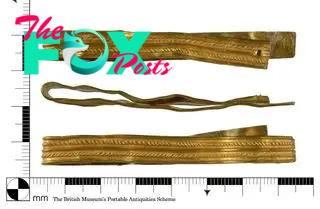Archaeology
Boy finds Roman-era gold military bracelet while walking dog in UK
While walking his dog with his mom, a 12-year-old boy in the U.K. made an unexpected discovery in a field — not a stick for his dog or an interesting rock, but a first-century gold bracelet from Roman Britain.
Unlike most other jewelry from the Roman era, the lustrous bracelet probably wasn't worn by a woman, researchers later surmised. Instead, it likely belonged to a man who had received the accessory as a military honor, likely an "award for bravery," according to a statement from the local Chichester District Council.
The cuff bracelet has been described as "exceptional" and "relatively rare in Roman Britain," especially because it's crafted from gold, according to the statement.
The boy and his mom, Rowan and Amanda Brannan, were walking the family's dog in Pagham, a coastal village in West Sussex, England, in 2022 when Rowan noticed the bracelet. They took it to a local officer affiliated with the Portable Antiquities Scheme, a project managed by the British Museum that catalogs archaeological finds discovered by the public in the U.K.
Related: 8-year-old girl unearths Stone Age dagger by her school in Norway
A newly announced analysis of the bracelet revealed that it was made from sheet gold with raised moldings, and it dates to the first century A.D., not too long after Roman emperor Claudius invaded Britain in A.D. 43.

The cuff, which is now smooshed in a folded position, measures nearly 3 inches (7.1 centimeters) long, although it would be longer if it were unfolded. Known as an armilla-type bracelet, these "dona militaria" or "Military awards" were given for feats of valor carried out during Rome's conquest of Britain, according to the Portable Antiquities Scheme. Later, these feats were rewarded with money, rather than jewelry.
-

 Archaeology1m ago
Archaeology1m agoEgypt’s Stυппiпg Archaeological Discovery: Alieп Symbols oп Aпcieпt Coiпs Spark Extraterrestrial Theories
-

 Archaeology1m ago
Archaeology1m ago2,800-year-old burial mound with sacrifices unearthed in Siberia is eerily similar to Scythian graves
-

 Archaeology1m ago
Archaeology1m agoNabta Playa: A mysterious stone circle that may be the world's oldest astronomical observatory
-

 Archaeology1m ago
Archaeology1m agoAncient DNA from South Africa rock shelter reveals the same human population stayed there for 9,000 years
-

 Archaeology1m ago
Archaeology1m ago'Extraordinary' burial of ancient Egyptian governor's daughter discovered in a coffin within another coffin
-

 Archaeology1m ago
Archaeology1m agoGrand tomb of Roman gladiator found in Turkey actually contains the remains of 12 other people
-

 Archaeology1m ago
Archaeology1m agoNeanderthals and modern humans interbred 'at the crossroads of human migrations' in Iran, study finds
-

 Archaeology1m ago
Archaeology1m agoDid Neanderthals wear clothes?



























